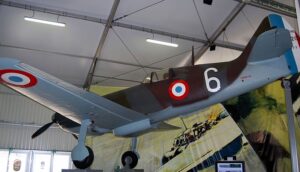Time Period: World War II (WW2)
Country of Origin: United Kingdom
Type: Fighter Aircraft, Interceptor Aircraft
Manufacturer: Hawker Aircraft
Hawker Tempest Aircraft Overview
The Hawker Tempest is a British single-seat fighter aircraft that was designed and built by Hawker Aircraft during World War II. It was developed as an improved version of the Hawker Typhoon, which had been used primarily for ground-attack missions.
The Tempest was powered by a Napier Sabre liquid-cooled engine, which gave it a top speed of around 435 miles per hour. It was armed with four 20mm Hispano Mk V cannon and could also carry bombs and rockets for ground-attack missions. The Tempest was designed to be a high-altitude interceptor, and it was equipped with a pressurized cockpit to allow the pilot to operate at high altitudes.
The Tempest saw combat in the later stages of World War II, and it was particularly effective against the V-1 flying bombs that were used by Germany in their attacks on Britain. It was also used for ground-attack missions and was successful in attacking enemy aircraft on the ground.
After the war, the Tempest was used by several air forces, including the Royal Air Force and the Indian Air Force. It was eventually replaced by more advanced jet-powered fighters, but it remained in service with some air forces until the early 1950s.
The Tempest was highly regarded by pilots for its speed, agility, and firepower, and it was one of the most successful British fighter aircraft of World War II. Several examples of the Tempest can still be seen today in museums and private collections around the world.
Hawker Tempest Mk.V Specifications
- Crew: 1
- Length: 33 ft 8 in (10.26 m)
- Wingspan: 41 ft 0 in (12.50 m)
- Height: 14 ft 10 in (4.52 m) (tail in rigging position with one propeller blade vertical) ; 16 ft 1 in (4.90 m) (tail down with one propeller blade vertical)
- Wing area: 302 sq ft (28.1 m2)
- Airfoil: root:Hawker H.14/14/37.5 ; tip:Hawker H.14/10/37.5 (maximum thickness at 37.5% chord)
- Gross weight: 11,400 lb (5,171 kg) as interceptor; 12,500 lb (5,700 kg) with 2x 500 lb (230 kg) bombs; 13,500 lb (6,100 kg) with 2x 1,000 lb (450 kg) bombs)
- Fuel capacity: 160 imp gal (190 US gal; 730 l) internal with optional 90 imp gal (110 US gal; 410 l) or 180 imp gal (220 US gal; 820 l) in two drop tanks under wings
- Oil tank capacity: 16 imp gal (19 US gal; 73 l)
- Powerplant: 1 × Napier Sabre IIB H-24 liquid-cooled sleeve-valve piston engine, 2,420 hp (1,800 kW) at + 11 lb boost for 5 minutes at sea level; 2,010 hp (1,500 kW) for take-off ; 2,045 hp (1,525 kW) at 13,750 ft (4,190 m)
- Propellers: 4-bladed de Havilland Hydromatic, 14 ft (4.3 m) diameter constant-speed propeller.
Hawker Tempest Mk.V Performance
- Maximum speed: 435 mph (700 km/h, 378 kn) at 17,000 ft (5,200 m) ; 390 mph (340 kn; 630 km/h) at sea level
- Combat range: 420 mi (680 km, 360 nmi)
- Service ceiling: 36,500 ft (11,100 m)
- Rate of climb: 4,700 ft/min (24 m/s)
- Time to altitude: 20,000 ft (6,100 m) in 6 minutes at combat power
- Wing loading: 44.7 lb/sq ft (218 kg/m2) at 13,500 lb (6,100 kg)
- Power/mass: 0.149 hp/lb (0.245 kW/kg) at 13,500 lb (6,100 kg)
Hawker Tempest Mk.V Armament
- 4 × 20 mm (0.787 in) Mark II Hispano cannon, 200 rpg. Later models used Mark V Hispano cannon.
- with
- 2 × 500 lb (230 kg) or 1,000 lb (450 kg) bombs
- 8 × 3 in (76.20 mm) RP-3 rockets (post-Second World War)
- Provision for 2 × 45 imp gal (54 US gal; 200 l) or 2 × 90 imp gal (110 US gal; 410 l) drop tanks.
Hawker Tempest Image Gallery
More Hawker Aircraft

Hawker Sea Fury
The Hawker Sea Fury was a British fighter aircraft and one of the fastest production single reciprocating engine aircraft ever built.

Hawker Hurricane
The Hawker Hurricane was a British single-seat fighter aircraft designed in the 1930s and used by the Royal Air Force (RAF) during WW2.

Hawker Fury
The Hawker Fury was a British biplane fighter aircraft designed and manufactured by Hawker Aircraft Limited in the late 1920s.

Hawker Nimrod
The Hawker Nimrod is a British single-engined, single-seat biplane fighter aircraft built by Hawker Aircraft in the early 1930s.










